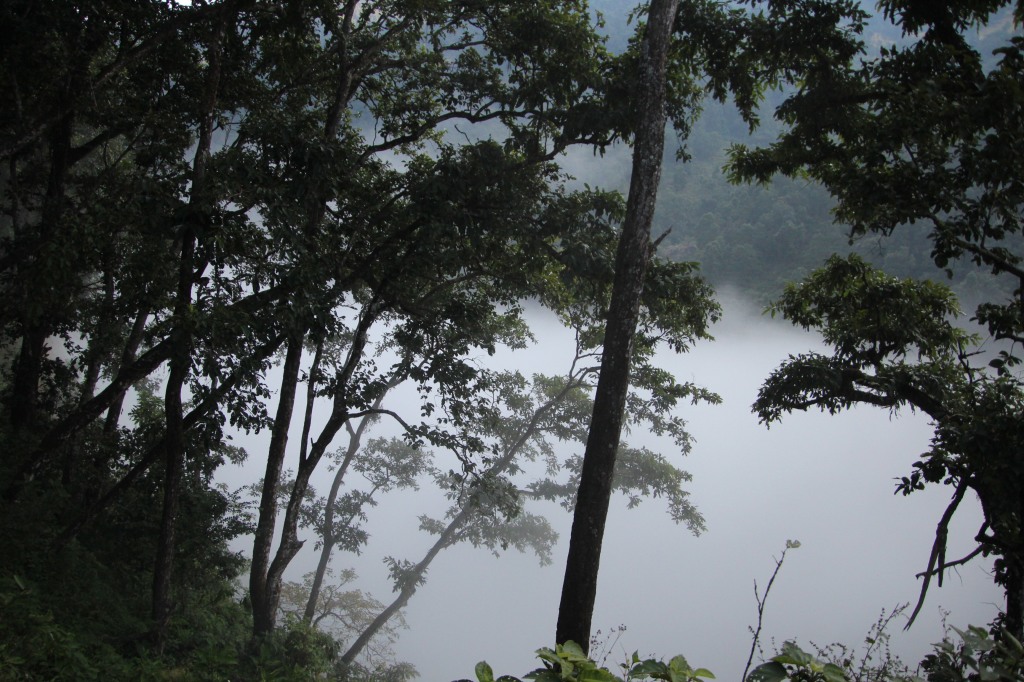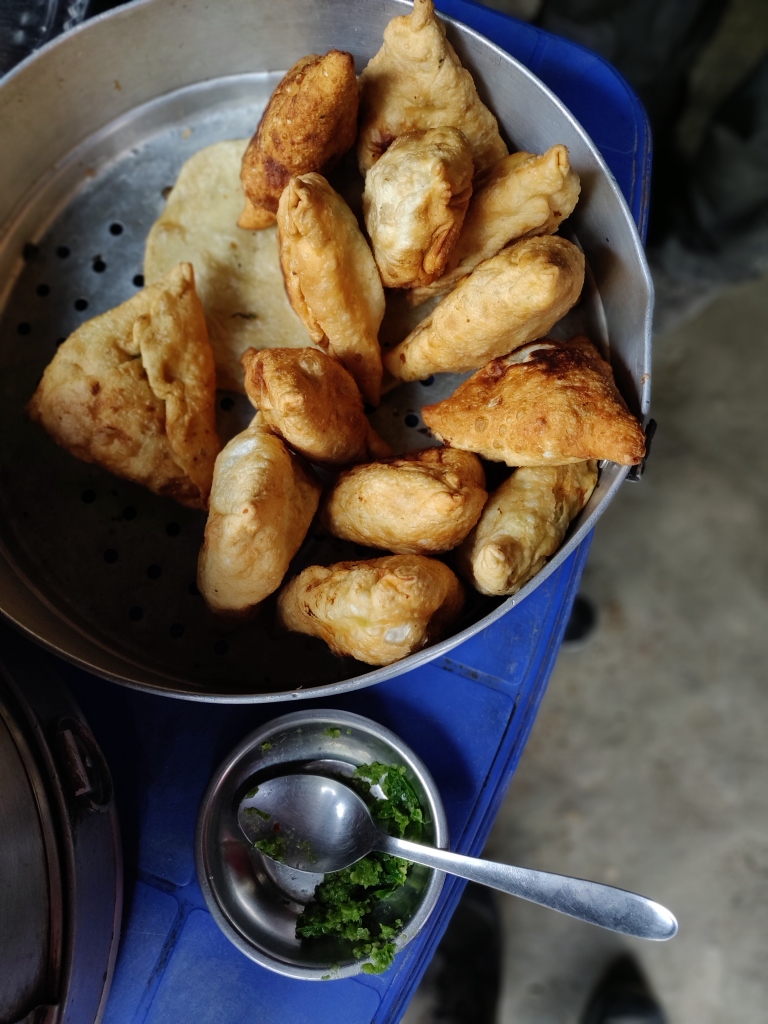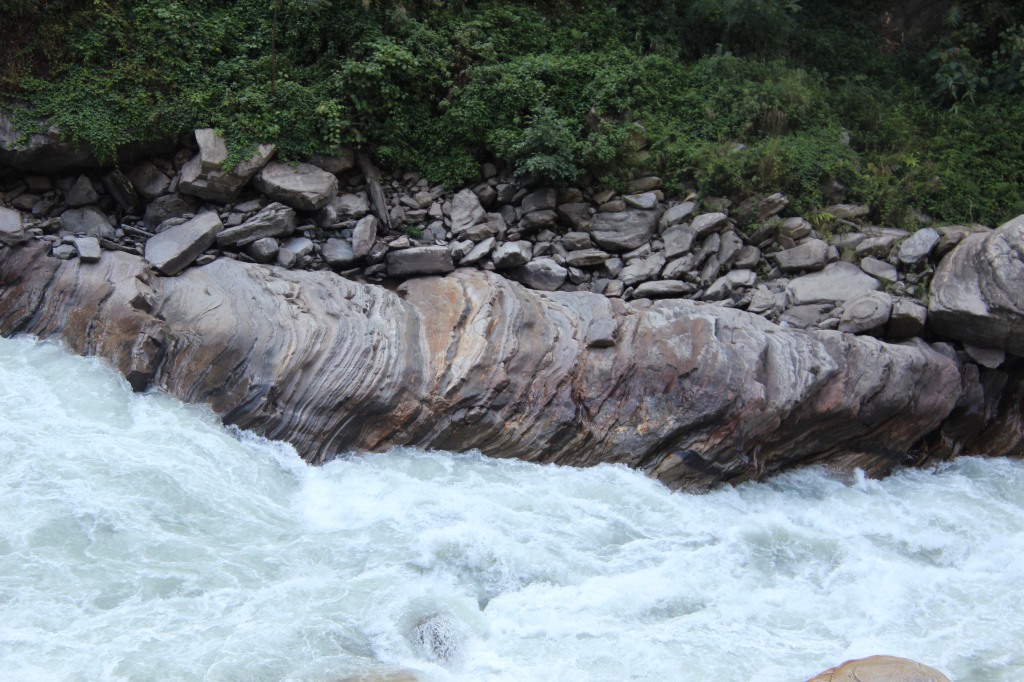4th November, 2019
Previous night, our guide briefed us about the day’s plan at the dinner table. His English is difficult to follow and he doesn’t know Hindi. It proved challenging for us to follow his words, but as the trek went through, we got used to him. The plan for the day was to walk up to Machhakhola, the next destination on the route. This was the first day of trekking. I finished the breakfast with corn flakes and milk, while others had pancakes or muesli. It was time to stripe up our respective backpacks and get going. Everybody carried two bottles of lukewarm water with them. The bags were ready, accounts were squared up at the tea house, the sticks were in our hands and we were ready to hit the trail.

We strode past other lodges and the trail moved gradually upwards. Mist rose from the valley and surrounded us.

It was cold to start with and we had our jackets on. However, as the sun came out and slopes headed up, we felt the warmth and had to peel off. Niladri in fact stripped down to his half pant, a trend that would continue for the days we were on the lower reaches of the trail. The Budhi Gandaki roared down the gorge and kept its presence felt with the continuous sound of its torrents. The early morning mist gave way to bright sunshine with clear skies. Walking was a treat in such surroundings. The slope was gentle, the sunshine was bright. The lush green forests were soothing to our eyes. The trail was still wide enough and there were tracts of tyres clearly visible to us, indicating that Sotikhola was not the last destination accessible by vehicles. I recalled Tej Gurung’s words last year during our Annapurna trek. “Visit Manaslu before road construction erases the trail!”. Sings were now visible that over the years to come, days of walking will continue to get trimmed off with the advancement of road. We were told that a road was being constructed from Machhakhola to Larkya La (the highest point on this trail), meaning a large section of the circuit trail will become redundant in the coming years. The future of the tea houses will also be impacted. Similar fate has been witnessed on the Annapurna Circuit trail, which now requires just 2-3 days of walking. Tea houses at the lower reaches have been made largely redundant as trekkers can now directly reach Manang by road.

Villages were nestled amidst the high slopes of the mountains. Houses were surrounded by terraced fields. Villagers were at work in the fields. Some kids passed by on their way to local school. We carried lozenges with us and were generous about distributing them to the kids whom we met on our way.

Waterfalls kept coming down the slopes. Some even crossed our ways. We had to be careful while crossing them. Though the torrents were not fast, but they were deep and we had to cross them by placing our feet over the precariously placed rocks that dotted the streams.

The first four days of the trek were supposed to be long, approximately 18-19 kms a day. Today was the start of it. With the weather playing fine, people kept their camera shutters rolling, but we also had to keep an eye on the time. Our past experiences in the Himalayas told us that the fine weather may not last in the second half and it’s in our interest to get to the destination before that eventuality.

Budhi Gandaki kept company all along. On our way, we came across a local shop along the road side. Samosas were being fried. Immediately, we all flocked around the seller, who was a lady. The samosas were big. We got to see the raw materials stacked around which included fresh green peas, boiled vegetables and potatoes. These lured us. She fried the samosas and kept serving. The taste was heavenly. A pickle prepared by grinding green chilies, salt and some local spices added taste to the flavor. The price was nothing when compared to the size of the samosas, their taste and above all, the surroundings. After a few bends, we got to see the distant houses of the Machhakhola village.

Machhakhola would be the site for lunch. Initially, it was supposed to be the destination for the day, but en-route, our guide decided to carry on after lunch for another 1-2 hours. That should lead us to Khorla Besi and hence, curtail the distance for the morrow by the same amount. The plan sounded sensible and we agreed to it. After reaching Machhakhola, we ordered lunch, which was Nepalese thali that included rice, lentils, vegetables and green chilies. This is the staple food of Nepal across all regions and for most of our destinations along the route, we stuck to this diet. As we started off after lunch, a light drizzle started, which increased on our way and finally we had to pull out our raincoats. Dhananjoy was walking ahead of rest of us and soon moved out of sight. Clouds now moved in front and covered the hills surrounding us. With clouds coming on, the cold increased.

After walking for sometime, we saw Dhananjoy standing beside the road in a local shop. After reaching there, he dropped a bomb shell . He had left his water bottles at the tea house at Machhakhola. Our destination for the day was just ahead. The porters were reluctant to go back and fetch the bottles. After some deliberations, Dhananjoy himself went back. It was a tough ask at the end of the day, to go back the distance we just covered and repeat the same journey. It would take him at least two to three hours more. With all of us exhausted by the day’s walking, it was painful to even think of it, but he had no other option. We plodded ahead and reached Khorla Besi, a small village nestled amidst the hills with just a few tea houses. Our sweatshirts were drenched and we hung them on the wires, but with the moisture in the atmosphere, their chances of drying up were feeble. After arrival of Dhananjoy, Niladri pulled out the snacks and tea bags from his repertoire and we chatted along. Evening wore on and after dinner at 7 PM, we subsided to our rooms. We were sleeping at 1200 m.
5th November, 2019
I spent the previous evening sweating over how to get my clothes dried. Hanging them outside didn’t work, so I laid them under my blanket and slept over them (with the hope of my body warmth drying them up). However, they were still wet when I woke up the next morning. Getting clothes dried in time was crucial as we had to reuse them (may be not on successive days, but every alternate 2/3 days). Finally, Niladri gave the idea of hanging them on my back while walking. The days were usually bright and clear, so why not let the Sun do its job. 5th November, 2019 was the first day when I tried that option and it continued throughout the trek. Bags were packed and handed over to porters. Our morning tea session started with discussion about the day’s plan. It was a long one. To reach Jagat, our next destination, we’d have to walk about 20 kms and would take almost the entire day. We left Khorla Besi after breakfast at about 7 AM in the morning. The trail continued up along the banks of Budhi Gandaki amidst bright sunshine, traversing through the valleys, ravines and the gorges.

Sections of the trail were broken by land slides and the route was riddled with boulders, pebbles and loose grounds. We skid frequently, especially when the trail moved down towards the river bank. The views were ecstatic, but we had to focus on our feet while moving over unsettled grounds. The frequency of landslides, narrow trails, rock fall zones on this route gave a feeling that we humans are not always welcome in these “internal” areas of nature. As if it was giving us signs to stay away. It doesn’t like these relentless intrusions in its interiors in the form of ever increasing tea houses, tourists and the accompanying road construction. The trail now descended to the banks of the river, which roared down the gorges.

Herds of ponies kept crossing us and we had to make way for them. They are the lifelines to the upper reaches of the region. One has to be careful while encountering these herds. The trails are narrow and there’s no luxury of space. The ponies are often burdened with loads and they don’t tolerate any obstruction on their way as it’s very difficult to contain their momentum with loaded backs. Hence, it’s the pedestrians who have the make way for them on the way up or down. Things can get tricky on narrow blind bends. Since you can’t see the other side (hidden from your vision by the mountain walls), you may come across them unexpectedly. But the good thing is they have bells hung in their necks which keep ringing and can be heard from a distance. The moment you hear them, keep an eye to judge how far they are at the back or in front and whether you can cross the upcoming narrow passage before they reach that point. Paving way for them isn’t easy always as space is a luxury on these trails at many places and at times, you have to slant your body along the rising walls to give them passage. The key here is to reach a convenient point of passage early enough where you can stand decently and wait for them to cross instead of clamoring for space which can be precarious and dangerous at times.

The river gave us ample opportunities to shoot and our shutters kept rolling. People posed by standing on the boulders with the river in the background.


Boulders studding the river bed, bore the signs of the flowing torrent over the years which carved its own sculpture and pattern over them. After walking down the banks, we came across a suspension bridge which carried us to the other bank and a steep hike followed. We passed along villages where people were engrossed in their daily work. That mainly involved working in the fields, taming the roaming herds of goats to guide them to the pastures or towards home. Kids continued to cross our ways and we obliged them by distributing lozenges. Greetings of “Namaste” (a standard Nepalese respectful greeting) were exchanged. This greeting would gradually change to “Tashi Delek” (the Tibetan word for welcome) in the upper reaches inhabited by Tibetan refugees who came across the high mountain passes from trans Himalayan regions to settle in those areas after Chinese occupation of Tibet.

We gave a halt for sometime to drink water. Our guide informed that we were nearing our place for lunch. Another half an hour should lead us there. He gave us corn grains to chew. Apparently, this gives oxygen which is helpful in the higher altitudes. When we reached there, we saw just a few tea houses on the edge of a wide valley. The river Budhi Gandaki flowed through many streams spread wide across the huge valley that formed an amphitheater surrounded by hills. It was an exquisite place to have lunch.

We sat around the table as lunch was being prepared. The standard dal bhaat, the staple food of Nepal. Ranjan da pulled out his bottle of pickle made of green chilies. Every item on the menu was repeated as many times as we wished. We could see the walkway along the vertical rocky walls that rose above the valley of Budhi Gandaki.

This walkway deserves some mention. The earthquake of 2015 and the changing courses of the rivers had devastating effects on the trail to Jagat. At times, these events eroded large sections of the old trail. For quite sometime, the access to Jagat was through steep rising trails followed by sharp and dangerous drops. People from the valleys of Tsum, Nubri and other remote areas are heavily dependent on supplies and aids from the lower regions which were difficult to reach since the trail between Machhakhola and Jagat got severely damaged by the aforesaid events. Then, a Swiss company was tasked to make the trail safe in this section. After a superb display of engineering and an arduous effort put in by the locals, they came up with what is now called the walkway. It is a level steel bridge supported by angular structures clamped into the vertical rocky walls that rose up from the valley. After lunch, we resumed our walk and crossed a stoned stair case to reach the newly built walkway.

It was a treat to walk on this and we thanked the efforts of the people who built this. It was almost like walking along a level footpath in the high mountainous regions. After the end of it, another stone staircase brought us down to the valley again and a gradual trail followed which led us to the base of another suspension bridge that carried us to the other bank of Budhi Gandaki. Helicopters were making trips to the other side of the valley indicating the presence of a helipad nearby. After sometime we could see the distant houses of the village of Jagat. As we entered its outskirts, we were welcomed by a board of Manaslu Conservation Area Project (MCAP).

A map of the trek route was also on display with the prominent places, mountain peaks and passes marked out. Jagat is also the place where our permits would get checked. Our guide went to the MCAP office to have our permits checked.

We headed to our tea house. A single four-bedded room was allocated to us. Our bags reached there before. After changing to homewears, we sat on the beds with our usual tea and snacks session. Conversations involved our experience during the day, the new walkway, some friendly banters, leg pulling and the plan for the morrow, which would take us to the next destination Deng. The tea house had WiFi available and we called our respective homes to inform about our safe journey and health. A sense of relief, completion and satisfaction prevailed. After dinner, we went under the blankets. We were sleeping at 1370 m.

Road are being constructed in many himalayan treks making treks shorter. While this is beneficial to the villages and the locals, it will bring along with it all the ills of modernization. I really don’t know which is better….I just hope the sanctity of these interior places are maintained even though they get all the modern amenities, chances are rare though….
The samosas sound heavenly. And, I am a big fan of Nepali Thali.
Having to go back and get the water bottle that too at the fag end of the day is seriously painful.
You put this in a nice way – humans are not always welcome in these “internal” areas of nature – nature gives back in it’s own way.
Walking for 18-20 Km each day is huge! How did you prepare physically and mentally for that?
The walkway looks amazing, how wonderful it would have been to walk on it.
LikeLike
Thanks for your comments. We just walk hard before going on such treks. A times, climb multi-stories by staircases. They only help in building patience while you long for reaching your destination. But views on the trails do help a lot. You certainly can’t do that (at least I can’t) on city roads.
LikeLiked by 1 person
I usually climb up stairs whenever possible trek or no trek, just as a way of keeping fit. Totally agree that you can’t do that on city roads at all. Moreover, pollution will kill you 😀
LikeLike
That’s why you might fare much better than me going for such treks. My interest disappears as soon as I’m back & only starts before the next one.
LikeLike
Waiting eagerly for the next episode 🙂
LikeLike
Just published now
LikeLiked by 1 person
Will read 🙂
LikeLike